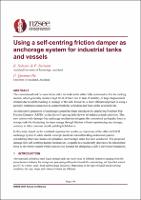| dc.contributor.author | Sahami, Kaveh | |
| dc.contributor.author | Zarnani, Pouyan | |
| dc.contributor.author | Quenneville, Pierre | |
| dc.date.accessioned | 2021-06-22T04:01:56Z | |
| dc.date.available | 2021-06-22T04:01:56Z | |
| dc.date.issued | 2021-04-14 | |
| dc.identifier.uri | https://repo.nzsee.org.nz/xmlui/handle/nzsee/2381 | |
| dc.description.abstract | The conventional tank’s connections make the tanks to be either fully restrained or free for rocking motion, which generally creates a high level of force due to lack of ductility or large displacement demand due to uplift resulting in damage of the tank. However, a more efficient approach is using a partially restrained connection to control both the deflection and force at the desired levels.
An innovative generation of anchorage system has been introduced by employing Resilient Slip Friction Dampers (RSFDs) as ductile self-centring hold-downs for industrial tanks and silos. This new tension-only damage-free anchorage mechanism mitigates the transmitted earthquake force to storage tanks by dissipating the input energy through friction without experiencing any damage, contrary to other common ductile yielding hold-downs.
In this study, based on the validated experimental results, a comparison of the effect of RSFD anchorage system to other ductile concepts (necked-rod and buckling-restrained system) considering three case studies of cylindrical steel storage tanks has been conducted. The proposed damage-free self-centring damper mechanism is capable to considerably decreases the transmitted force to the whole system which leads to less demand for designing a tank’s barrel and foundation. | |
| dc.language.iso | en | |
| dc.publisher | New Zealand Society for Earthquake Engineering | |
| dc.relation.ispartofseries | 2021;0096 | |
| dc.subject | Improving resilience of lifelines and infrastructure | |
| dc.title | Using a self-centring friction damper as anchorage system for industrial tanks and vessels | |
| dc.type | Article | |

